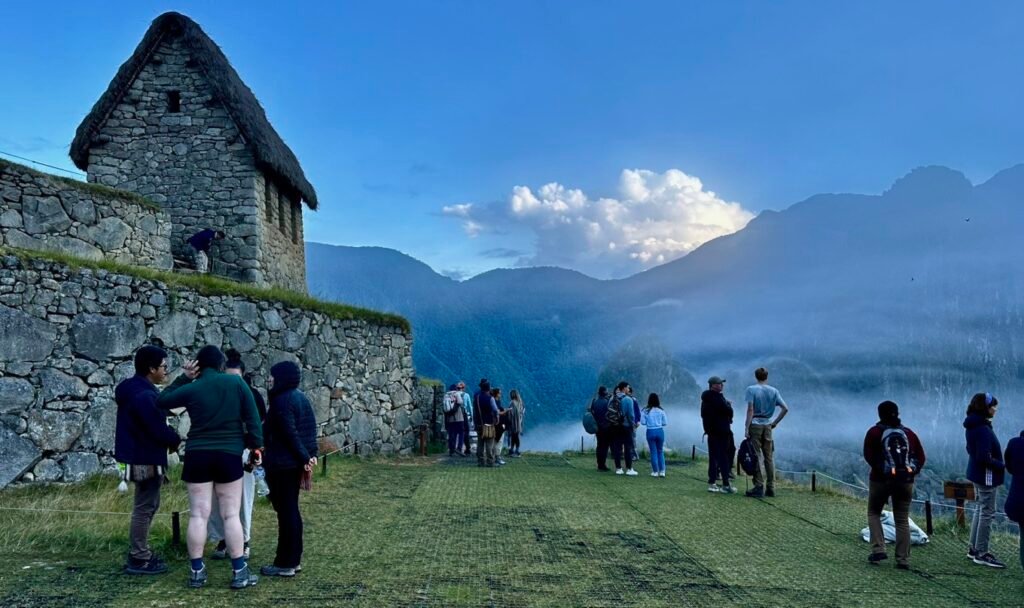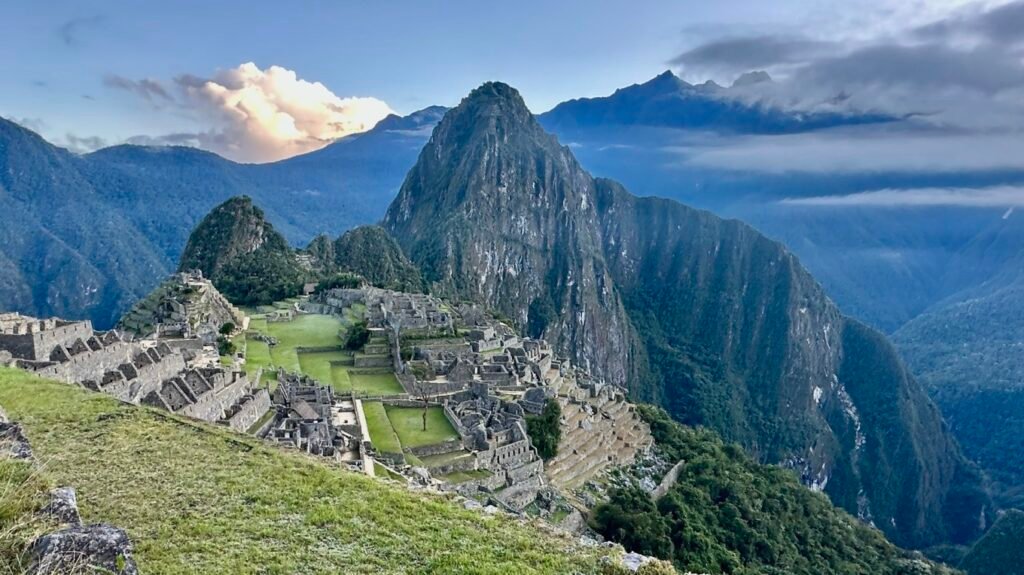Machu Picchu is an ancient Inca city located in southern Peru, renowned as one of the New Seven Wonders of the World. Built in the 15th century, it features classical Inca architecture with polished stone walls and precise masonry. Machu Picchu is a key archaeological site in South America and one of Peru’s most popular tourist destinations.
Journey to Machu Picchu from Lima
Upon arriving in Lima, Peru’s capital, the journey to Machu Picchu involves three stages. First, you can fly from Lima to Cusco, with LATAM, JetSmart, or SKYLINE as your airline options. LATAM tickets can be purchased using partner miles, though tickets are generally affordable. While traveling by car or bus is also possible, these alternatives are not recommended.
The second part of the journey takes you from Cusco through Ollantaytambo to Aguas Calientes, also known as Machu Picchu Town. Most travelers opt for a “bimodal” ticket, which includes both a bus ride and a train transfer. The segment from Cusco to Ollantaytambo involves a bus ride, but you can also make your own arrangements if you plan to explore the Sacred Valley en route. In that case, hiring a private car or joining a day tour to Ollantaytambo would be more convenient. For adventurers, the full Inca Trail trek to Machu Picchu over four days and three nights is available, costing around 795 USD per person.
Two companies operate the train service between Ollantaytambo and Aguas Calientes: IncaRail and PeruRail. PeruRail offers several train classes, including the Expedition, Vistadome, Vistadome Observatory, and the luxury Belmond Hiram Bingham. The prices range from 64 to 600 USD per person, with a ten percent discount for round-trip tickets. The Belmond service caters to luxury travelers and may not be the best option for those on a budget. Even the Vistadome Observatory, which I tried, felt unnecessary, despite its large windows, complimentary snacks, and onboard entertainment. The ticket cost was nearly double the standard fare, and they actively promote expensive beverages, which might be better to skip if you’re watching your budget. Keep in mind that PeruRail requires you to bring your online booking confirmation to the ticket office to print physical tickets.
The final stretch from Aguas Calientes to the entrance of Machu Picchu can be completed by shuttle bus, which costs 24 USD per person for a one-way ticket. While the price may seem steep, the bus is a much easier option than hiking up the mountain. Though hiking is possible, it is physically demanding and may not be worth the effort. You can purchase bus tickets from the designated “Bus Ticket” office, clearly marked with a large sign. Just follow the path to find the ticket counter easily.
This morning, we got really lucky at Machu Picchu. From the first viewpoint, we saw the legendary mist-covered Machu Picchu, exactly how I imagined the city in the sky would look.
As we climbed higher, the site gradually came into full view. Overlooking the Inca ruins, I tried hard to picture the grandeur of these ancient walls in their prime. At the highest viewpoint, which offers the best panoramic view of Machu Picchu, looking at it from a 90-degree angle clockwise, you can see the outline of several mountains that form a side profile of a face facing the sky. According to legend, this face was seen by the Inca king as a representation of the Inca people gazing up at the sun god.








Machu Picchu’s architecture is classic Inca style, featuring polished stone walls as its structural elements. The well-preserved facilities in the town include the Intihuatana (the Hitching Post of the Sun), the Temple of the Sun, and the Temple of the Three Windows. According to archaeologists, Machu Picchu was not an ordinary city but rather a rural retreat for Inca nobility. The site includes a vast palace, temples dedicated to Inca gods, and other buildings for the maintenance staff.


Aguas Calientes, also known as Machu Picchu Town, is the small town at the base of Machu Picchu, located about 6 kilometers away from the ruins. Walking to Machu Picchu requires a 1.5 to 2-hour trek, including a mountain climb. Since it’s the gateway to Machu Picchu, Aguas Calientes has become a major tourist hub. The town does have hot springs, but most of them are outdoors and can be quite chilly at times.





Machu Picchu, this ancient legend lost in the mist, seems like a mystery woven by nature and human civilization. Nestled in the embrace of the Andes Mountains in Peru, it’s like a forgotten gem quietly recounting its former glory and changes over time. As you step onto this mystical land, the first thing you notice is the green-clad mountains, shrouded in mist, almost like a fairytale. The Machu Picchu ruins are hidden in this deep natural embrace, surrounded by dense vegetation and steep cliffs. When the sunlight filters through the clouds and falls on the ruins, the ancient stones and steps seem to emit a golden glow, giving a sense of a timeless, mystical power.
Cusco-the capital of the Inca Empire
Cusco, a UNESCO World Heritage site, sits at an elevation of 3,400 meters. It was the capital of the Inca Empire, serving as the center for religion, culture, agriculture, and commerce. Today, remnants of Inca palaces, monuments, and the Temple of the Sun still stand. After the Spanish invasion in 1533, the city was colonized for over 300 years and underwent extensive Westernization, affecting everything from religion and language to architecture and lifestyle. The city’s historic center features grand Baroque-style churches and colonial buildings, many of which have been converted into restaurants, bars, travel agencies, and souvenir shops.


The Cusco Cathedral is a stunningly opulent building, most famous for its collection, including the “Last Supper.” This piece isn’t Leonardo da Vinci’s original but a copy by Marcos Zapata, where the table features a traditional Inca dish—guinea pig. Remarkably, the cathedral’s bell tower houses a 130-ton bell, known as the largest bell in South America.


In the Inca era, Cusco was the capital of the Inca Empire and considered the center of the world, with the Temple of the Sun being the highest authority. During the agricultural age, people prayed for the sun god never to disappear. At the Machu Picchu site, there are stone carvings meant to “anchor” the sun.


The Temple of the Sun, originally meaning “Golden Courtyard” in Quechua, now features a two-story Spanish-style courtyard with a surrounding gallery. Blooming flowers and the imposing bell tower leave visitors with endless imagination. What’s most striking about the Temple of the Sun is the clever blend of Western architecture with Inca ruins.


Inside the Temple of the Sun, you can see replicas of the original artifacts, including many religious paintings, sculptures, and sacred objects. The garden outside the temple is filled with a sense of mystery, evoking admiration and reverence for Inca culture. From the temple’s stone walls and railings, the view stretches out to the blue sky and white clouds, with distant rolling hills and scattered houses nestled in the mountains.


The largest stones at Sacsayhuamán Fortress weigh around 300 tons. The Incas didn’t use any steel or cement; instead, they employed advanced polishing techniques to shape the stones and fit them together perfectly. Located at an altitude of 3,700 meters, Sacsayhuamán was, in a way, like the Chinese practice of dismantling parts of the Great Wall to build houses. Many stones were removed for the construction of Cusco, and over time, weathering has altered the fortress’s original appearance. Sacsayhuamán is not only a must-visit spot for travelers to Cusco but also the site of the annual Inti Raymi festival celebrations.




